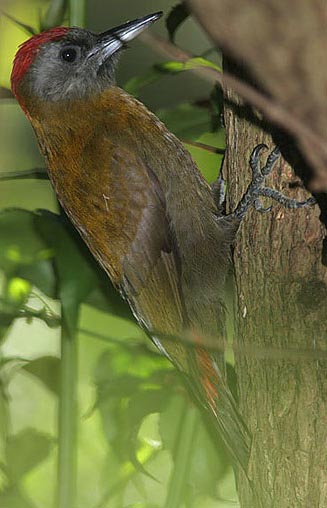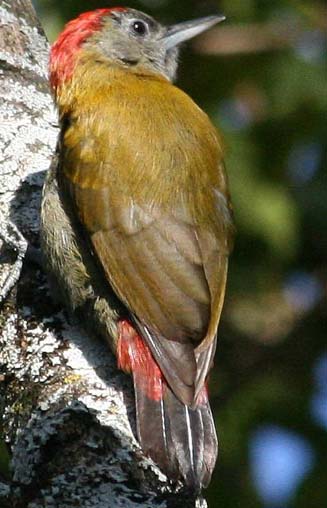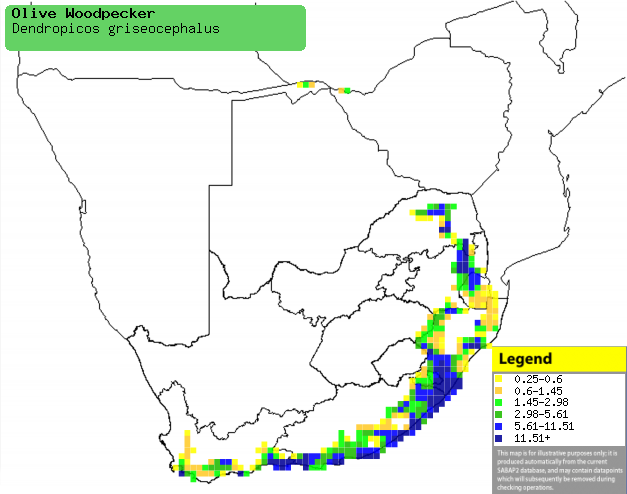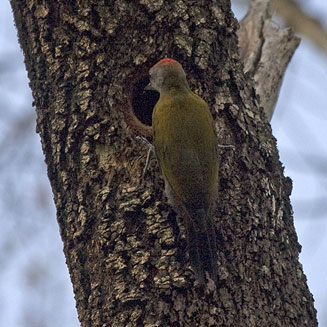|
Dendropicos griseocephalus (Olive
woodpecker)
[= Mesopicos griseocephalus]
Gryskopspeg [Afrikaans]; Mbangura (generic term for
woodpecker and also applied to Crested barbet) [Kwangali]; Olijfspecht [Dutch];
Pic olive [French]; Goldrückenspecht [German]; Pica-pau-de-cabeça-cinzenta
[Portuguese]
Life
> Eukaryotes >
Opisthokonta
> Metazoa (animals) >
Bilateria >
Deuterostomia > Chordata >
Craniata > Vertebrata (vertebrates) > Gnathostomata (jawed
vertebrates) > Teleostomi (teleost fish) > Osteichthyes (bony fish) > Class:
Sarcopterygii (lobe-finned
fish) > Stegocephalia (terrestrial
vertebrates) > Tetrapoda
(four-legged vertebrates) > Reptiliomorpha > Amniota >
Reptilia (reptiles) >
Romeriida > Diapsida > Archosauromorpha > Archosauria >
Dinosauria
(dinosaurs) > Saurischia > Theropoda (bipedal predatory dinosaurs) >
Coelurosauria > Maniraptora > Aves
(birds) >
Order: Piciformes
> Family: Picidae
 |
 |
|
Olive woodpecker, Harold Porter Botanical Gardens,
South Africa. [photo Trevor Hardaker ©] |
Olive woodpecker, Queen Elizabeth Park,
Pietermaritzburg, South Africa. [photo Alan Manson
©] |
The Olive woodpecker has two isolated subspecies in Africa -
one is in Central Africa, and the other is endemic to South Africa, living in
evergreen forests. It forages in the upper canopies of trees, probing pecking
branches, and licking them up with its barbed tongue. Both sexes excavate the
nest, which is usually a oval-shaped hole in the trunk of a tree. Here it lays
2-3 eggs, which are incubated by both sexes, for roughly 15-16 days. The chicks
are cared for by both parents, leaving the nest at about 24-26 days old. The
juveniles return to the nest to roost for about 3 months, at which point they
become fully independent.
For information about this species, see
www.birdforum.net/opus/Dendropicos_griseocephalus
Distribution and habitat
It has two isolated subspecies in Africa - one in Central Africa and the other
in South Africa, occurring along the escarpment and southern coast. It generally
prefers evergreen
forest, occasionally venturing into fynbos and suburban gardens.
|
 |
|
Distribution of Olive woodpecker in southern Africa,
based on statistical smoothing of the records from first SA Bird Atlas
Project (©
Animal Demography unit, University of
Cape Town; smoothing by Birgit Erni and Francesca Little). Colours range
from dark blue (most common) through to yellow (least common).
See here for the latest distribution
from the SABAP2. |
Brood parasites
It has been recorded as host of the
Lesser honeyguide and
Scaly-throated honeyguide.
Food
It usually forages in the upper canopies
of trees, probing and pecking branches before licking off prey with its barbed tongue.
The following food items have been recorded in its diet:
Breeding
- Both sexes excavate the nest (see image below), which is usually a oval-shaped hole in the
trunk of a tree.
 |
|
|
Olive woodpecker at its nest, Mpumalanga, South
Africa. [photo
Neil Gray
©] |
|
- Egg-laying season is from August-November, peaking from
September-October.
- It lays 2-3 eggs, which are incubated by both sexes for roughly 15-16
days.
- The chicks are cared for by both parents, leaving the nest at about
24-26 days old. The juveniles return to the nest to roost for about 3
months, after which they become fully independent.
Threats
Not threatened.
References
-
Hockey PAR, Dean WRJ and Ryan PG (eds) 2005. Roberts -
Birds of southern Africa, VIIth ed. The Trustees of the John Voelcker
Bird Book Fund, Cape Town.
|
